Understanding and Evaluation of Waste Management in UK Construction
VerifiedAdded on 2023/01/05
|36
|8820
|68
Report
AI Summary
This report provides a comprehensive analysis of waste management in the UK construction industry, focusing on the concept of sustainable development and its complexities. The study begins with an intellectual summary, keywords, and an introduction that highlights the growing construction sector and its impact on waste management. It defines the aims, objectives, research questions, rationale, and significance of the study, which is supported by Balfour Beatty plc. The report then delves into a detailed literature review, divided into two parts. Part I explores waste management, construction waste, sources of waste, and drivers of waste reduction in the UK. Part II examines sustainable construction and approaches to waste reduction within construction companies. The report includes data collection and analysis, culminating in a conclusion that summarizes the key findings and implications of the research. The report aims to understand the core concept of waste management and significance of sustainable development in the construction industry, identifying the sources of waste generation along with the drivers for minimisation of construction waste in UK and complexity in construction project.
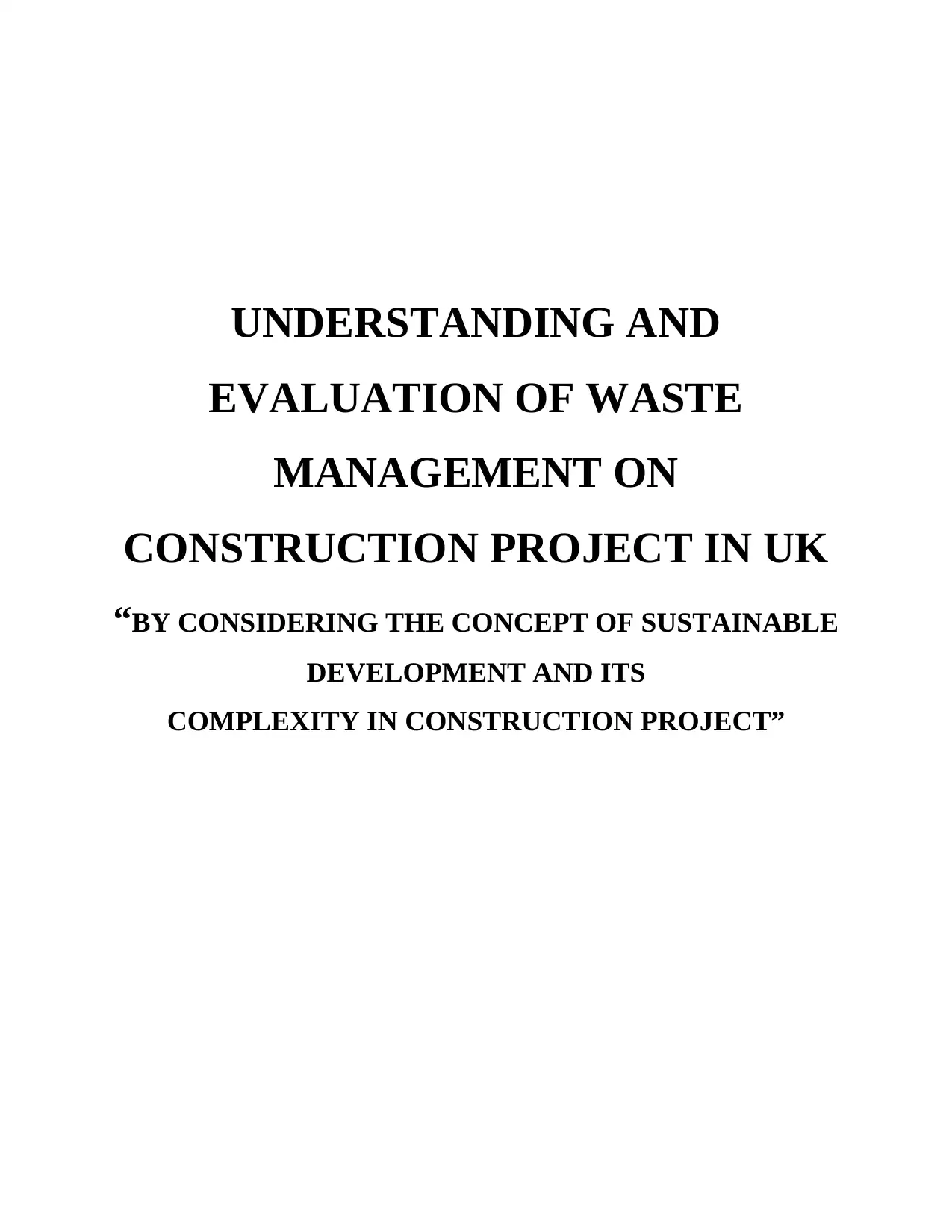
UNDERSTANDING AND
EVALUATION OF WASTE
MANAGEMENT ON
CONSTRUCTION PROJECT IN UK
“BY CONSIDERING THE CONCEPT OF SUSTAINABLE
DEVELOPMENT AND ITS
COMPLEXITY IN CONSTRUCTION PROJECT”
EVALUATION OF WASTE
MANAGEMENT ON
CONSTRUCTION PROJECT IN UK
“BY CONSIDERING THE CONCEPT OF SUSTAINABLE
DEVELOPMENT AND ITS
COMPLEXITY IN CONSTRUCTION PROJECT”
Paraphrase This Document
Need a fresh take? Get an instant paraphrase of this document with our AI Paraphraser
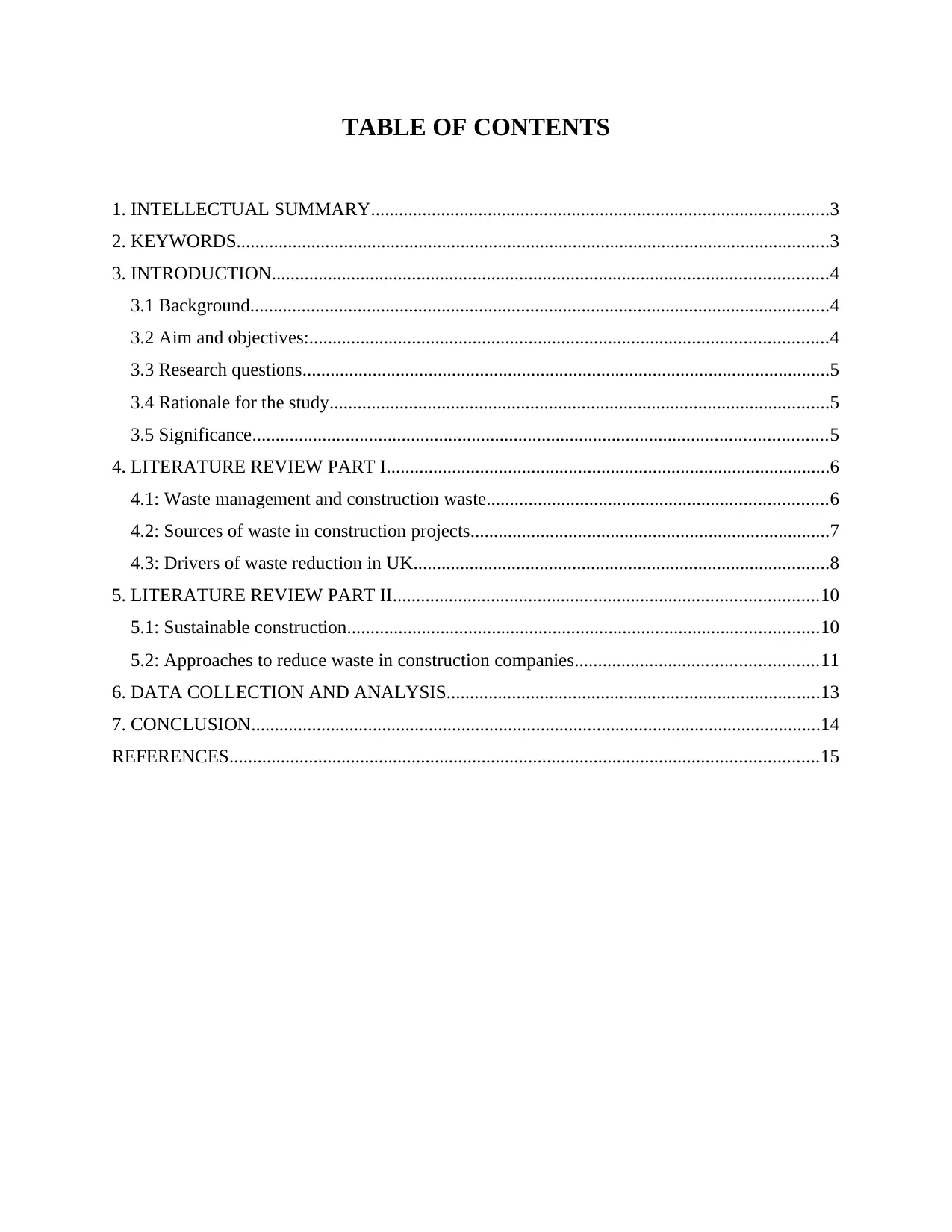
TABLE OF CONTENTS
1. INTELLECTUAL SUMMARY..................................................................................................3
2. KEYWORDS...............................................................................................................................3
3. INTRODUCTION.......................................................................................................................4
3.1 Background............................................................................................................................4
3.2 Aim and objectives:...............................................................................................................4
3.3 Research questions.................................................................................................................5
3.4 Rationale for the study...........................................................................................................5
3.5 Significance...........................................................................................................................5
4. LITERATURE REVIEW PART I...............................................................................................6
4.1: Waste management and construction waste.........................................................................6
4.2: Sources of waste in construction projects.............................................................................7
4.3: Drivers of waste reduction in UK.........................................................................................8
5. LITERATURE REVIEW PART II...........................................................................................10
5.1: Sustainable construction.....................................................................................................10
5.2: Approaches to reduce waste in construction companies....................................................11
6. DATA COLLECTION AND ANALYSIS................................................................................13
7. CONCLUSION..........................................................................................................................14
REFERENCES..............................................................................................................................15
1. INTELLECTUAL SUMMARY..................................................................................................3
2. KEYWORDS...............................................................................................................................3
3. INTRODUCTION.......................................................................................................................4
3.1 Background............................................................................................................................4
3.2 Aim and objectives:...............................................................................................................4
3.3 Research questions.................................................................................................................5
3.4 Rationale for the study...........................................................................................................5
3.5 Significance...........................................................................................................................5
4. LITERATURE REVIEW PART I...............................................................................................6
4.1: Waste management and construction waste.........................................................................6
4.2: Sources of waste in construction projects.............................................................................7
4.3: Drivers of waste reduction in UK.........................................................................................8
5. LITERATURE REVIEW PART II...........................................................................................10
5.1: Sustainable construction.....................................................................................................10
5.2: Approaches to reduce waste in construction companies....................................................11
6. DATA COLLECTION AND ANALYSIS................................................................................13
7. CONCLUSION..........................................................................................................................14
REFERENCES..............................................................................................................................15
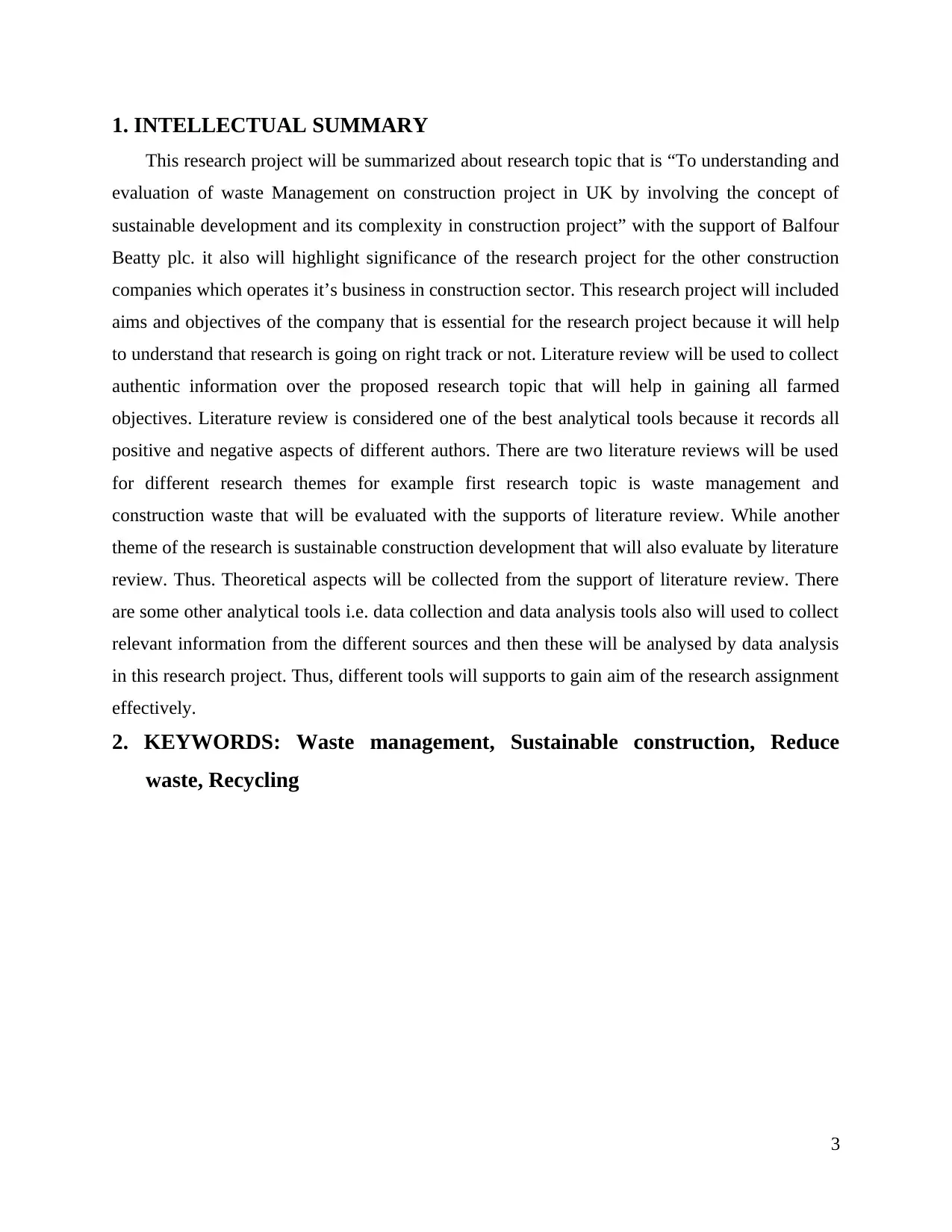
1. INTELLECTUAL SUMMARY
This research project will be summarized about research topic that is “To understanding and
evaluation of waste Management on construction project in UK by involving the concept of
sustainable development and its complexity in construction project” with the support of Balfour
Beatty plc. it also will highlight significance of the research project for the other construction
companies which operates it’s business in construction sector. This research project will included
aims and objectives of the company that is essential for the research project because it will help
to understand that research is going on right track or not. Literature review will be used to collect
authentic information over the proposed research topic that will help in gaining all farmed
objectives. Literature review is considered one of the best analytical tools because it records all
positive and negative aspects of different authors. There are two literature reviews will be used
for different research themes for example first research topic is waste management and
construction waste that will be evaluated with the supports of literature review. While another
theme of the research is sustainable construction development that will also evaluate by literature
review. Thus. Theoretical aspects will be collected from the support of literature review. There
are some other analytical tools i.e. data collection and data analysis tools also will used to collect
relevant information from the different sources and then these will be analysed by data analysis
in this research project. Thus, different tools will supports to gain aim of the research assignment
effectively.
2. KEYWORDS: Waste management, Sustainable construction, Reduce
waste, Recycling
3
This research project will be summarized about research topic that is “To understanding and
evaluation of waste Management on construction project in UK by involving the concept of
sustainable development and its complexity in construction project” with the support of Balfour
Beatty plc. it also will highlight significance of the research project for the other construction
companies which operates it’s business in construction sector. This research project will included
aims and objectives of the company that is essential for the research project because it will help
to understand that research is going on right track or not. Literature review will be used to collect
authentic information over the proposed research topic that will help in gaining all farmed
objectives. Literature review is considered one of the best analytical tools because it records all
positive and negative aspects of different authors. There are two literature reviews will be used
for different research themes for example first research topic is waste management and
construction waste that will be evaluated with the supports of literature review. While another
theme of the research is sustainable construction development that will also evaluate by literature
review. Thus. Theoretical aspects will be collected from the support of literature review. There
are some other analytical tools i.e. data collection and data analysis tools also will used to collect
relevant information from the different sources and then these will be analysed by data analysis
in this research project. Thus, different tools will supports to gain aim of the research assignment
effectively.
2. KEYWORDS: Waste management, Sustainable construction, Reduce
waste, Recycling
3
⊘ This is a preview!⊘
Do you want full access?
Subscribe today to unlock all pages.

Trusted by 1+ million students worldwide

4
Paraphrase This Document
Need a fresh take? Get an instant paraphrase of this document with our AI Paraphraser
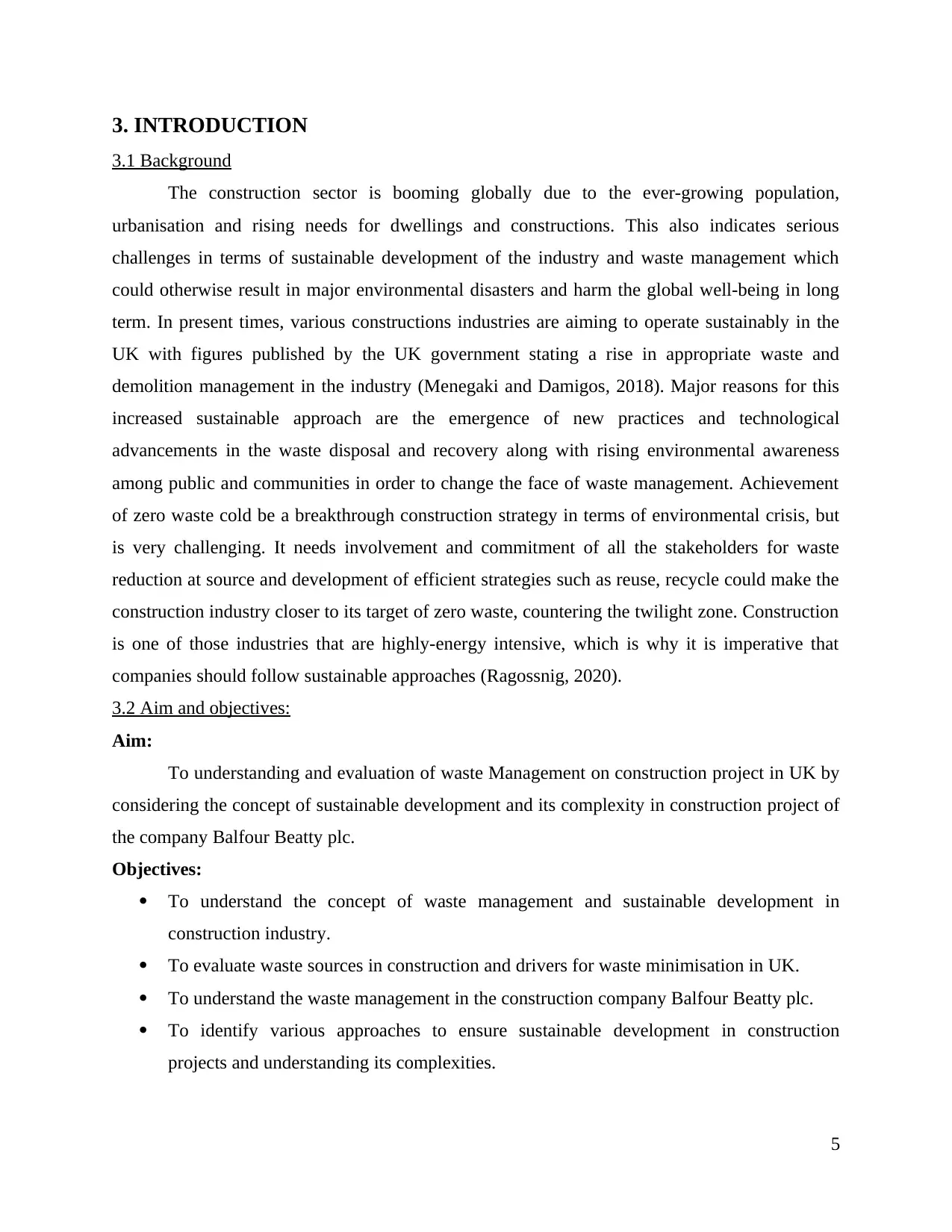
3. INTRODUCTION
3.1 Background
The construction sector is booming globally due to the ever-growing population,
urbanisation and rising needs for dwellings and constructions. This also indicates serious
challenges in terms of sustainable development of the industry and waste management which
could otherwise result in major environmental disasters and harm the global well-being in long
term. In present times, various constructions industries are aiming to operate sustainably in the
UK with figures published by the UK government stating a rise in appropriate waste and
demolition management in the industry (Menegaki and Damigos, 2018). Major reasons for this
increased sustainable approach are the emergence of new practices and technological
advancements in the waste disposal and recovery along with rising environmental awareness
among public and communities in order to change the face of waste management. Achievement
of zero waste cold be a breakthrough construction strategy in terms of environmental crisis, but
is very challenging. It needs involvement and commitment of all the stakeholders for waste
reduction at source and development of efficient strategies such as reuse, recycle could make the
construction industry closer to its target of zero waste, countering the twilight zone. Construction
is one of those industries that are highly-energy intensive, which is why it is imperative that
companies should follow sustainable approaches (Ragossnig, 2020).
3.2 Aim and objectives:
Aim:
To understanding and evaluation of waste Management on construction project in UK by
considering the concept of sustainable development and its complexity in construction project of
the company Balfour Beatty plc.
Objectives:
To understand the concept of waste management and sustainable development in
construction industry.
To evaluate waste sources in construction and drivers for waste minimisation in UK.
To understand the waste management in the construction company Balfour Beatty plc.
To identify various approaches to ensure sustainable development in construction
projects and understanding its complexities.
5
3.1 Background
The construction sector is booming globally due to the ever-growing population,
urbanisation and rising needs for dwellings and constructions. This also indicates serious
challenges in terms of sustainable development of the industry and waste management which
could otherwise result in major environmental disasters and harm the global well-being in long
term. In present times, various constructions industries are aiming to operate sustainably in the
UK with figures published by the UK government stating a rise in appropriate waste and
demolition management in the industry (Menegaki and Damigos, 2018). Major reasons for this
increased sustainable approach are the emergence of new practices and technological
advancements in the waste disposal and recovery along with rising environmental awareness
among public and communities in order to change the face of waste management. Achievement
of zero waste cold be a breakthrough construction strategy in terms of environmental crisis, but
is very challenging. It needs involvement and commitment of all the stakeholders for waste
reduction at source and development of efficient strategies such as reuse, recycle could make the
construction industry closer to its target of zero waste, countering the twilight zone. Construction
is one of those industries that are highly-energy intensive, which is why it is imperative that
companies should follow sustainable approaches (Ragossnig, 2020).
3.2 Aim and objectives:
Aim:
To understanding and evaluation of waste Management on construction project in UK by
considering the concept of sustainable development and its complexity in construction project of
the company Balfour Beatty plc.
Objectives:
To understand the concept of waste management and sustainable development in
construction industry.
To evaluate waste sources in construction and drivers for waste minimisation in UK.
To understand the waste management in the construction company Balfour Beatty plc.
To identify various approaches to ensure sustainable development in construction
projects and understanding its complexities.
5
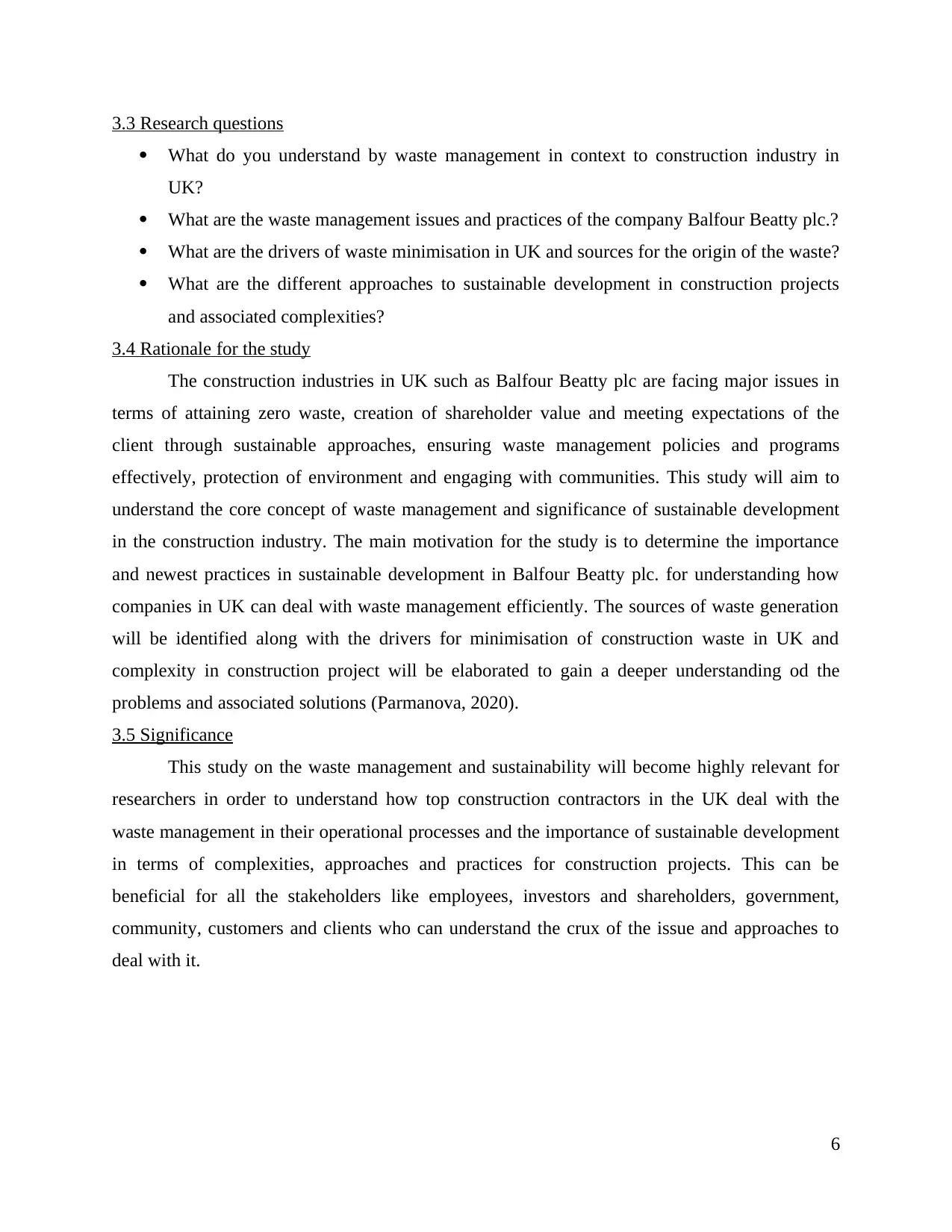
3.3 Research questions
What do you understand by waste management in context to construction industry in
UK?
What are the waste management issues and practices of the company Balfour Beatty plc.?
What are the drivers of waste minimisation in UK and sources for the origin of the waste?
What are the different approaches to sustainable development in construction projects
and associated complexities?
3.4 Rationale for the study
The construction industries in UK such as Balfour Beatty plc are facing major issues in
terms of attaining zero waste, creation of shareholder value and meeting expectations of the
client through sustainable approaches, ensuring waste management policies and programs
effectively, protection of environment and engaging with communities. This study will aim to
understand the core concept of waste management and significance of sustainable development
in the construction industry. The main motivation for the study is to determine the importance
and newest practices in sustainable development in Balfour Beatty plc. for understanding how
companies in UK can deal with waste management efficiently. The sources of waste generation
will be identified along with the drivers for minimisation of construction waste in UK and
complexity in construction project will be elaborated to gain a deeper understanding od the
problems and associated solutions (Parmanova, 2020).
3.5 Significance
This study on the waste management and sustainability will become highly relevant for
researchers in order to understand how top construction contractors in the UK deal with the
waste management in their operational processes and the importance of sustainable development
in terms of complexities, approaches and practices for construction projects. This can be
beneficial for all the stakeholders like employees, investors and shareholders, government,
community, customers and clients who can understand the crux of the issue and approaches to
deal with it.
6
What do you understand by waste management in context to construction industry in
UK?
What are the waste management issues and practices of the company Balfour Beatty plc.?
What are the drivers of waste minimisation in UK and sources for the origin of the waste?
What are the different approaches to sustainable development in construction projects
and associated complexities?
3.4 Rationale for the study
The construction industries in UK such as Balfour Beatty plc are facing major issues in
terms of attaining zero waste, creation of shareholder value and meeting expectations of the
client through sustainable approaches, ensuring waste management policies and programs
effectively, protection of environment and engaging with communities. This study will aim to
understand the core concept of waste management and significance of sustainable development
in the construction industry. The main motivation for the study is to determine the importance
and newest practices in sustainable development in Balfour Beatty plc. for understanding how
companies in UK can deal with waste management efficiently. The sources of waste generation
will be identified along with the drivers for minimisation of construction waste in UK and
complexity in construction project will be elaborated to gain a deeper understanding od the
problems and associated solutions (Parmanova, 2020).
3.5 Significance
This study on the waste management and sustainability will become highly relevant for
researchers in order to understand how top construction contractors in the UK deal with the
waste management in their operational processes and the importance of sustainable development
in terms of complexities, approaches and practices for construction projects. This can be
beneficial for all the stakeholders like employees, investors and shareholders, government,
community, customers and clients who can understand the crux of the issue and approaches to
deal with it.
6
⊘ This is a preview!⊘
Do you want full access?
Subscribe today to unlock all pages.

Trusted by 1+ million students worldwide
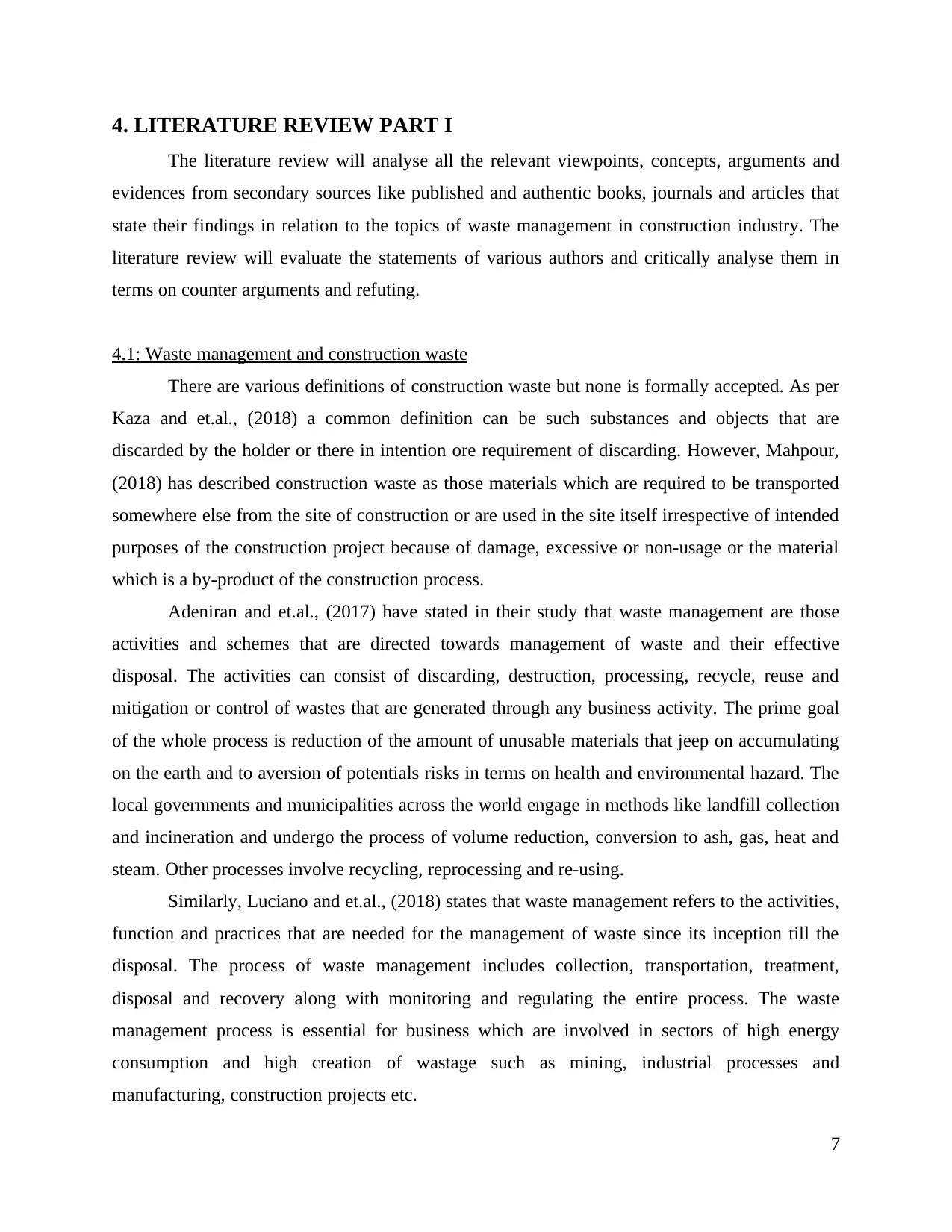
4. LITERATURE REVIEW PART I
The literature review will analyse all the relevant viewpoints, concepts, arguments and
evidences from secondary sources like published and authentic books, journals and articles that
state their findings in relation to the topics of waste management in construction industry. The
literature review will evaluate the statements of various authors and critically analyse them in
terms on counter arguments and refuting.
4.1: Waste management and construction waste
There are various definitions of construction waste but none is formally accepted. As per
Kaza and et.al., (2018) a common definition can be such substances and objects that are
discarded by the holder or there in intention ore requirement of discarding. However, Mahpour,
(2018) has described construction waste as those materials which are required to be transported
somewhere else from the site of construction or are used in the site itself irrespective of intended
purposes of the construction project because of damage, excessive or non-usage or the material
which is a by-product of the construction process.
Adeniran and et.al., (2017) have stated in their study that waste management are those
activities and schemes that are directed towards management of waste and their effective
disposal. The activities can consist of discarding, destruction, processing, recycle, reuse and
mitigation or control of wastes that are generated through any business activity. The prime goal
of the whole process is reduction of the amount of unusable materials that jeep on accumulating
on the earth and to aversion of potentials risks in terms on health and environmental hazard. The
local governments and municipalities across the world engage in methods like landfill collection
and incineration and undergo the process of volume reduction, conversion to ash, gas, heat and
steam. Other processes involve recycling, reprocessing and re-using.
Similarly, Luciano and et.al., (2018) states that waste management refers to the activities,
function and practices that are needed for the management of waste since its inception till the
disposal. The process of waste management includes collection, transportation, treatment,
disposal and recovery along with monitoring and regulating the entire process. The waste
management process is essential for business which are involved in sectors of high energy
consumption and high creation of wastage such as mining, industrial processes and
manufacturing, construction projects etc.
7
The literature review will analyse all the relevant viewpoints, concepts, arguments and
evidences from secondary sources like published and authentic books, journals and articles that
state their findings in relation to the topics of waste management in construction industry. The
literature review will evaluate the statements of various authors and critically analyse them in
terms on counter arguments and refuting.
4.1: Waste management and construction waste
There are various definitions of construction waste but none is formally accepted. As per
Kaza and et.al., (2018) a common definition can be such substances and objects that are
discarded by the holder or there in intention ore requirement of discarding. However, Mahpour,
(2018) has described construction waste as those materials which are required to be transported
somewhere else from the site of construction or are used in the site itself irrespective of intended
purposes of the construction project because of damage, excessive or non-usage or the material
which is a by-product of the construction process.
Adeniran and et.al., (2017) have stated in their study that waste management are those
activities and schemes that are directed towards management of waste and their effective
disposal. The activities can consist of discarding, destruction, processing, recycle, reuse and
mitigation or control of wastes that are generated through any business activity. The prime goal
of the whole process is reduction of the amount of unusable materials that jeep on accumulating
on the earth and to aversion of potentials risks in terms on health and environmental hazard. The
local governments and municipalities across the world engage in methods like landfill collection
and incineration and undergo the process of volume reduction, conversion to ash, gas, heat and
steam. Other processes involve recycling, reprocessing and re-using.
Similarly, Luciano and et.al., (2018) states that waste management refers to the activities,
function and practices that are needed for the management of waste since its inception till the
disposal. The process of waste management includes collection, transportation, treatment,
disposal and recovery along with monitoring and regulating the entire process. The waste
management process is essential for business which are involved in sectors of high energy
consumption and high creation of wastage such as mining, industrial processes and
manufacturing, construction projects etc.
7
Paraphrase This Document
Need a fresh take? Get an instant paraphrase of this document with our AI Paraphraser
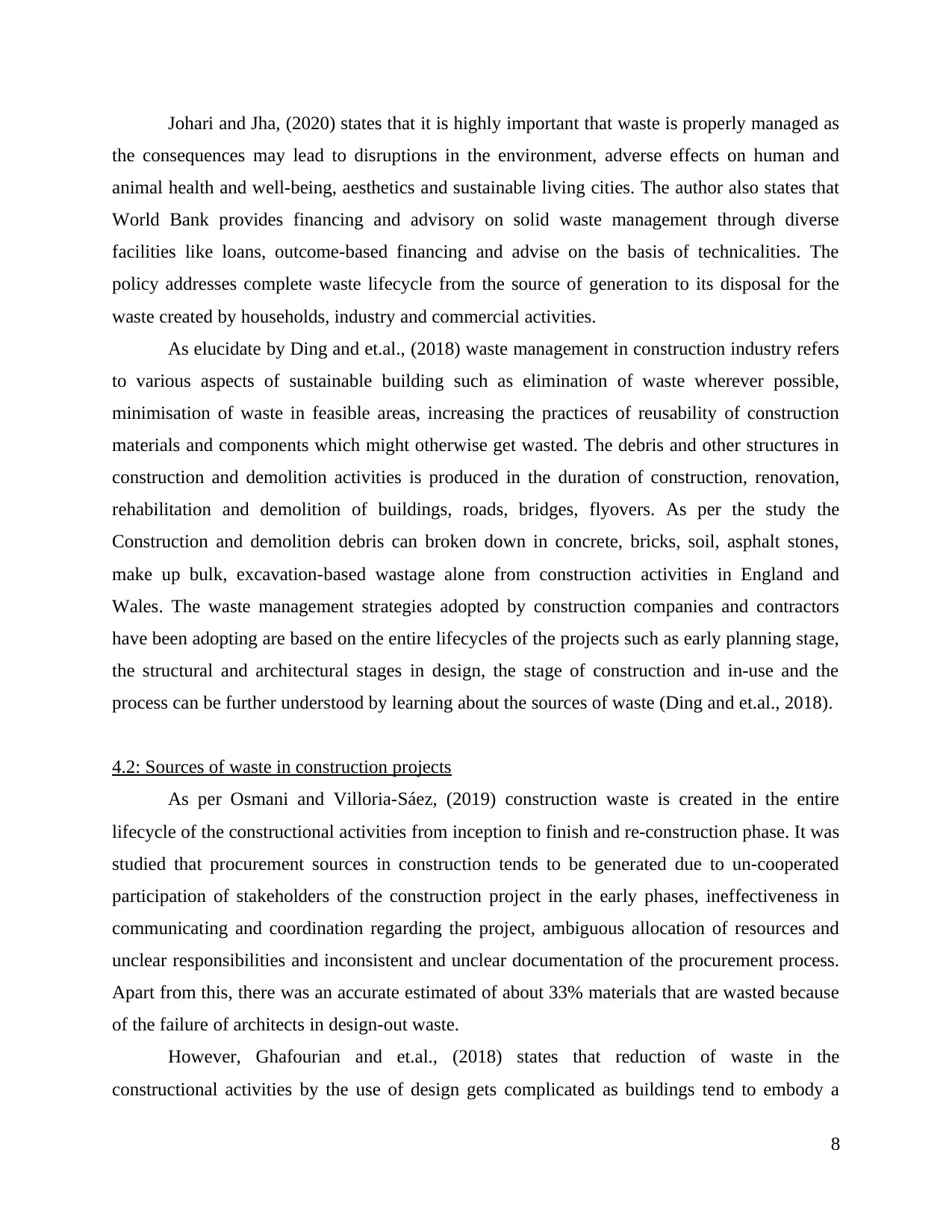
Johari and Jha, (2020) states that it is highly important that waste is properly managed as
the consequences may lead to disruptions in the environment, adverse effects on human and
animal health and well-being, aesthetics and sustainable living cities. The author also states that
World Bank provides financing and advisory on solid waste management through diverse
facilities like loans, outcome-based financing and advise on the basis of technicalities. The
policy addresses complete waste lifecycle from the source of generation to its disposal for the
waste created by households, industry and commercial activities.
As elucidate by Ding and et.al., (2018) waste management in construction industry refers
to various aspects of sustainable building such as elimination of waste wherever possible,
minimisation of waste in feasible areas, increasing the practices of reusability of construction
materials and components which might otherwise get wasted. The debris and other structures in
construction and demolition activities is produced in the duration of construction, renovation,
rehabilitation and demolition of buildings, roads, bridges, flyovers. As per the study the
Construction and demolition debris can broken down in concrete, bricks, soil, asphalt stones,
make up bulk, excavation-based wastage alone from construction activities in England and
Wales. The waste management strategies adopted by construction companies and contractors
have been adopting are based on the entire lifecycles of the projects such as early planning stage,
the structural and architectural stages in design, the stage of construction and in-use and the
process can be further understood by learning about the sources of waste (Ding and et.al., 2018).
4.2: Sources of waste in construction projects
As per Osmani and Villoria-Sáez, (2019) construction waste is created in the entire
lifecycle of the constructional activities from inception to finish and re-construction phase. It was
studied that procurement sources in construction tends to be generated due to un-cooperated
participation of stakeholders of the construction project in the early phases, ineffectiveness in
communicating and coordination regarding the project, ambiguous allocation of resources and
unclear responsibilities and inconsistent and unclear documentation of the procurement process.
Apart from this, there was an accurate estimated of about 33% materials that are wasted because
of the failure of architects in design-out waste.
However, Ghafourian and et.al., (2018) states that reduction of waste in the
constructional activities by the use of design gets complicated as buildings tend to embody a
8
the consequences may lead to disruptions in the environment, adverse effects on human and
animal health and well-being, aesthetics and sustainable living cities. The author also states that
World Bank provides financing and advisory on solid waste management through diverse
facilities like loans, outcome-based financing and advise on the basis of technicalities. The
policy addresses complete waste lifecycle from the source of generation to its disposal for the
waste created by households, industry and commercial activities.
As elucidate by Ding and et.al., (2018) waste management in construction industry refers
to various aspects of sustainable building such as elimination of waste wherever possible,
minimisation of waste in feasible areas, increasing the practices of reusability of construction
materials and components which might otherwise get wasted. The debris and other structures in
construction and demolition activities is produced in the duration of construction, renovation,
rehabilitation and demolition of buildings, roads, bridges, flyovers. As per the study the
Construction and demolition debris can broken down in concrete, bricks, soil, asphalt stones,
make up bulk, excavation-based wastage alone from construction activities in England and
Wales. The waste management strategies adopted by construction companies and contractors
have been adopting are based on the entire lifecycles of the projects such as early planning stage,
the structural and architectural stages in design, the stage of construction and in-use and the
process can be further understood by learning about the sources of waste (Ding and et.al., 2018).
4.2: Sources of waste in construction projects
As per Osmani and Villoria-Sáez, (2019) construction waste is created in the entire
lifecycle of the constructional activities from inception to finish and re-construction phase. It was
studied that procurement sources in construction tends to be generated due to un-cooperated
participation of stakeholders of the construction project in the early phases, ineffectiveness in
communicating and coordination regarding the project, ambiguous allocation of resources and
unclear responsibilities and inconsistent and unclear documentation of the procurement process.
Apart from this, there was an accurate estimated of about 33% materials that are wasted because
of the failure of architects in design-out waste.
However, Ghafourian and et.al., (2018) states that reduction of waste in the
constructional activities by the use of design gets complicated as buildings tend to embody a
8
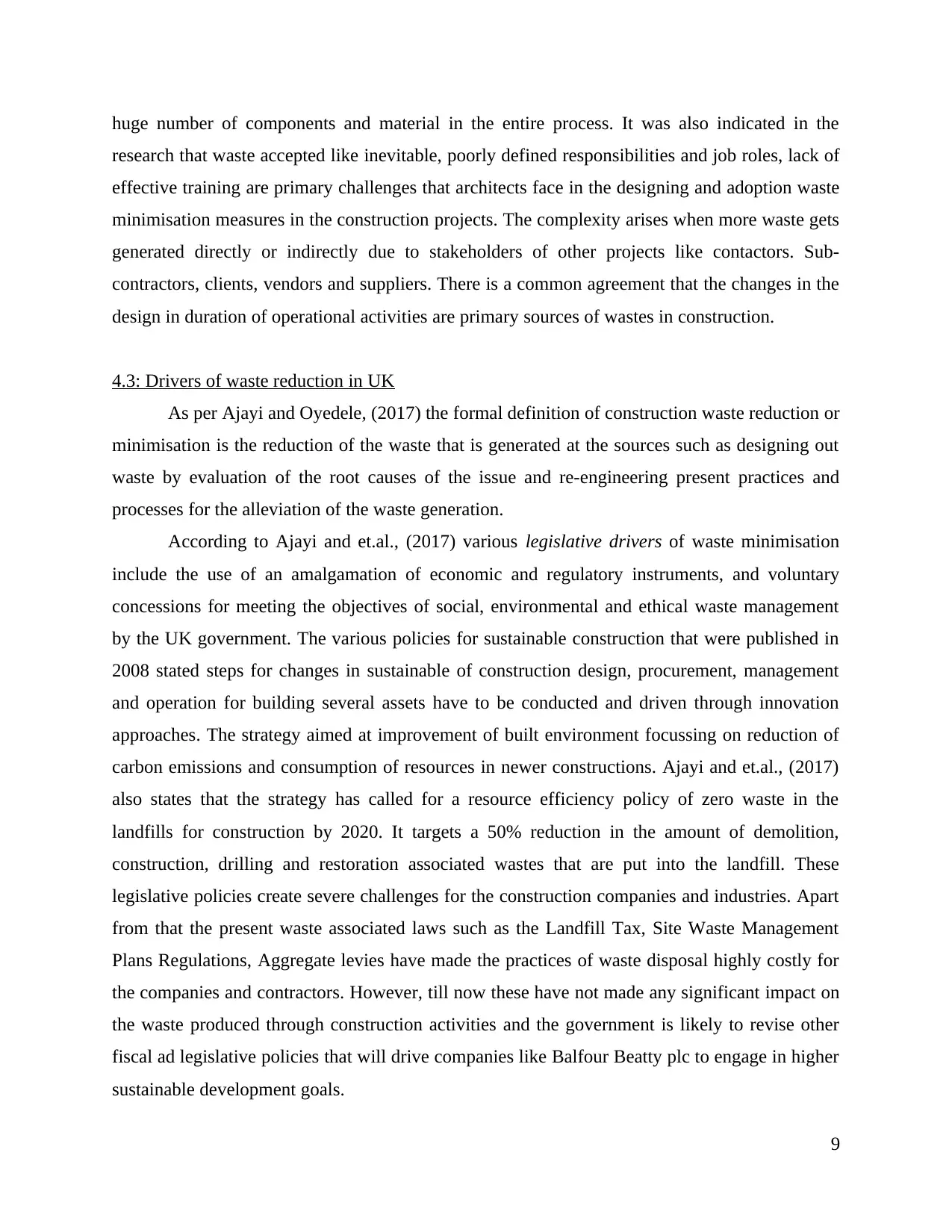
huge number of components and material in the entire process. It was also indicated in the
research that waste accepted like inevitable, poorly defined responsibilities and job roles, lack of
effective training are primary challenges that architects face in the designing and adoption waste
minimisation measures in the construction projects. The complexity arises when more waste gets
generated directly or indirectly due to stakeholders of other projects like contactors. Sub-
contractors, clients, vendors and suppliers. There is a common agreement that the changes in the
design in duration of operational activities are primary sources of wastes in construction.
4.3: Drivers of waste reduction in UK
As per Ajayi and Oyedele, (2017) the formal definition of construction waste reduction or
minimisation is the reduction of the waste that is generated at the sources such as designing out
waste by evaluation of the root causes of the issue and re-engineering present practices and
processes for the alleviation of the waste generation.
According to Ajayi and et.al., (2017) various legislative drivers of waste minimisation
include the use of an amalgamation of economic and regulatory instruments, and voluntary
concessions for meeting the objectives of social, environmental and ethical waste management
by the UK government. The various policies for sustainable construction that were published in
2008 stated steps for changes in sustainable of construction design, procurement, management
and operation for building several assets have to be conducted and driven through innovation
approaches. The strategy aimed at improvement of built environment focussing on reduction of
carbon emissions and consumption of resources in newer constructions. Ajayi and et.al., (2017)
also states that the strategy has called for a resource efficiency policy of zero waste in the
landfills for construction by 2020. It targets a 50% reduction in the amount of demolition,
construction, drilling and restoration associated wastes that are put into the landfill. These
legislative policies create severe challenges for the construction companies and industries. Apart
from that the present waste associated laws such as the Landfill Tax, Site Waste Management
Plans Regulations, Aggregate levies have made the practices of waste disposal highly costly for
the companies and contractors. However, till now these have not made any significant impact on
the waste produced through construction activities and the government is likely to revise other
fiscal ad legislative policies that will drive companies like Balfour Beatty plc to engage in higher
sustainable development goals.
9
research that waste accepted like inevitable, poorly defined responsibilities and job roles, lack of
effective training are primary challenges that architects face in the designing and adoption waste
minimisation measures in the construction projects. The complexity arises when more waste gets
generated directly or indirectly due to stakeholders of other projects like contactors. Sub-
contractors, clients, vendors and suppliers. There is a common agreement that the changes in the
design in duration of operational activities are primary sources of wastes in construction.
4.3: Drivers of waste reduction in UK
As per Ajayi and Oyedele, (2017) the formal definition of construction waste reduction or
minimisation is the reduction of the waste that is generated at the sources such as designing out
waste by evaluation of the root causes of the issue and re-engineering present practices and
processes for the alleviation of the waste generation.
According to Ajayi and et.al., (2017) various legislative drivers of waste minimisation
include the use of an amalgamation of economic and regulatory instruments, and voluntary
concessions for meeting the objectives of social, environmental and ethical waste management
by the UK government. The various policies for sustainable construction that were published in
2008 stated steps for changes in sustainable of construction design, procurement, management
and operation for building several assets have to be conducted and driven through innovation
approaches. The strategy aimed at improvement of built environment focussing on reduction of
carbon emissions and consumption of resources in newer constructions. Ajayi and et.al., (2017)
also states that the strategy has called for a resource efficiency policy of zero waste in the
landfills for construction by 2020. It targets a 50% reduction in the amount of demolition,
construction, drilling and restoration associated wastes that are put into the landfill. These
legislative policies create severe challenges for the construction companies and industries. Apart
from that the present waste associated laws such as the Landfill Tax, Site Waste Management
Plans Regulations, Aggregate levies have made the practices of waste disposal highly costly for
the companies and contractors. However, till now these have not made any significant impact on
the waste produced through construction activities and the government is likely to revise other
fiscal ad legislative policies that will drive companies like Balfour Beatty plc to engage in higher
sustainable development goals.
9
⊘ This is a preview!⊘
Do you want full access?
Subscribe today to unlock all pages.

Trusted by 1+ million students worldwide
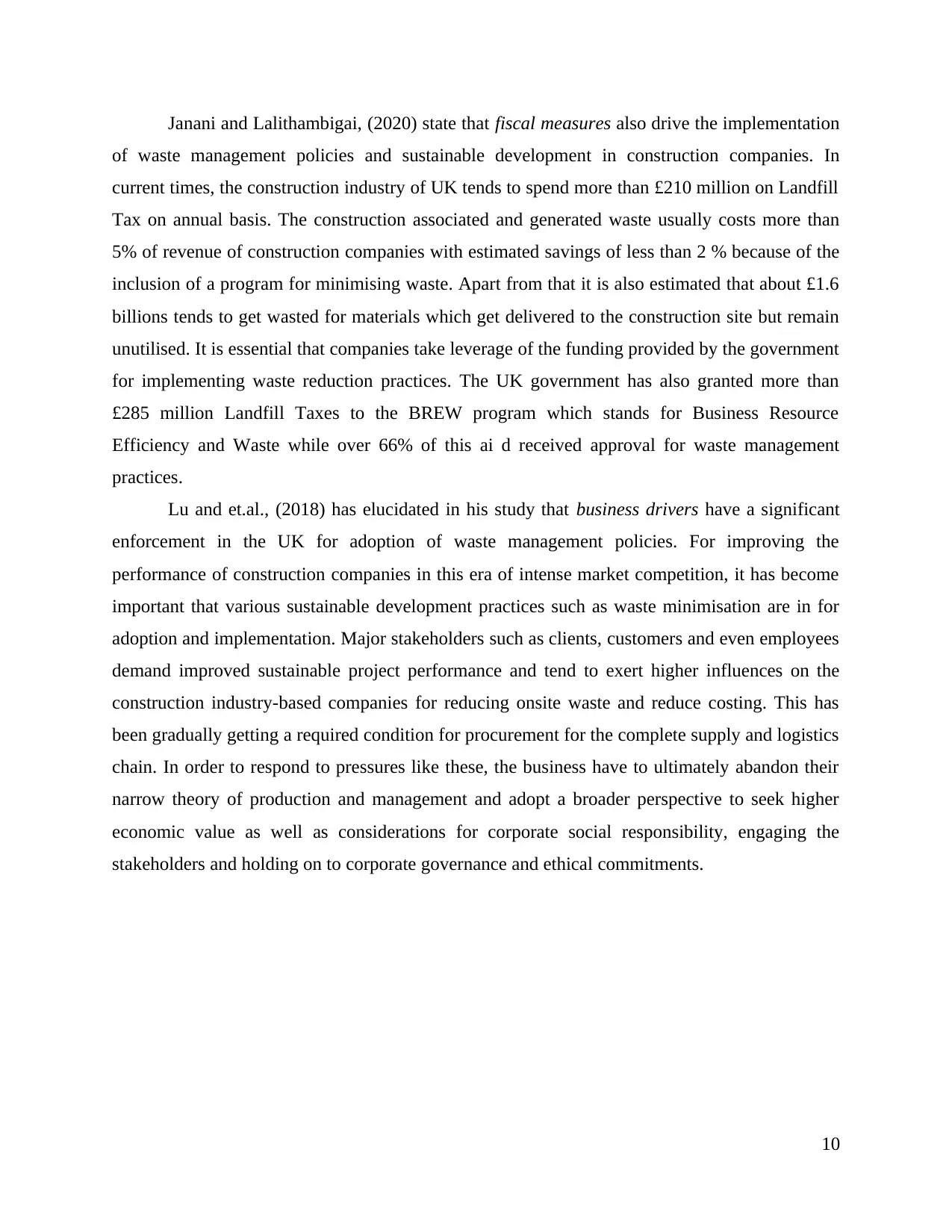
Janani and Lalithambigai, (2020) state that fiscal measures also drive the implementation
of waste management policies and sustainable development in construction companies. In
current times, the construction industry of UK tends to spend more than £210 million on Landfill
Tax on annual basis. The construction associated and generated waste usually costs more than
5% of revenue of construction companies with estimated savings of less than 2 % because of the
inclusion of a program for minimising waste. Apart from that it is also estimated that about £1.6
billions tends to get wasted for materials which get delivered to the construction site but remain
unutilised. It is essential that companies take leverage of the funding provided by the government
for implementing waste reduction practices. The UK government has also granted more than
£285 million Landfill Taxes to the BREW program which stands for Business Resource
Efficiency and Waste while over 66% of this ai d received approval for waste management
practices.
Lu and et.al., (2018) has elucidated in his study that business drivers have a significant
enforcement in the UK for adoption of waste management policies. For improving the
performance of construction companies in this era of intense market competition, it has become
important that various sustainable development practices such as waste minimisation are in for
adoption and implementation. Major stakeholders such as clients, customers and even employees
demand improved sustainable project performance and tend to exert higher influences on the
construction industry-based companies for reducing onsite waste and reduce costing. This has
been gradually getting a required condition for procurement for the complete supply and logistics
chain. In order to respond to pressures like these, the business have to ultimately abandon their
narrow theory of production and management and adopt a broader perspective to seek higher
economic value as well as considerations for corporate social responsibility, engaging the
stakeholders and holding on to corporate governance and ethical commitments.
10
of waste management policies and sustainable development in construction companies. In
current times, the construction industry of UK tends to spend more than £210 million on Landfill
Tax on annual basis. The construction associated and generated waste usually costs more than
5% of revenue of construction companies with estimated savings of less than 2 % because of the
inclusion of a program for minimising waste. Apart from that it is also estimated that about £1.6
billions tends to get wasted for materials which get delivered to the construction site but remain
unutilised. It is essential that companies take leverage of the funding provided by the government
for implementing waste reduction practices. The UK government has also granted more than
£285 million Landfill Taxes to the BREW program which stands for Business Resource
Efficiency and Waste while over 66% of this ai d received approval for waste management
practices.
Lu and et.al., (2018) has elucidated in his study that business drivers have a significant
enforcement in the UK for adoption of waste management policies. For improving the
performance of construction companies in this era of intense market competition, it has become
important that various sustainable development practices such as waste minimisation are in for
adoption and implementation. Major stakeholders such as clients, customers and even employees
demand improved sustainable project performance and tend to exert higher influences on the
construction industry-based companies for reducing onsite waste and reduce costing. This has
been gradually getting a required condition for procurement for the complete supply and logistics
chain. In order to respond to pressures like these, the business have to ultimately abandon their
narrow theory of production and management and adopt a broader perspective to seek higher
economic value as well as considerations for corporate social responsibility, engaging the
stakeholders and holding on to corporate governance and ethical commitments.
10
Paraphrase This Document
Need a fresh take? Get an instant paraphrase of this document with our AI Paraphraser
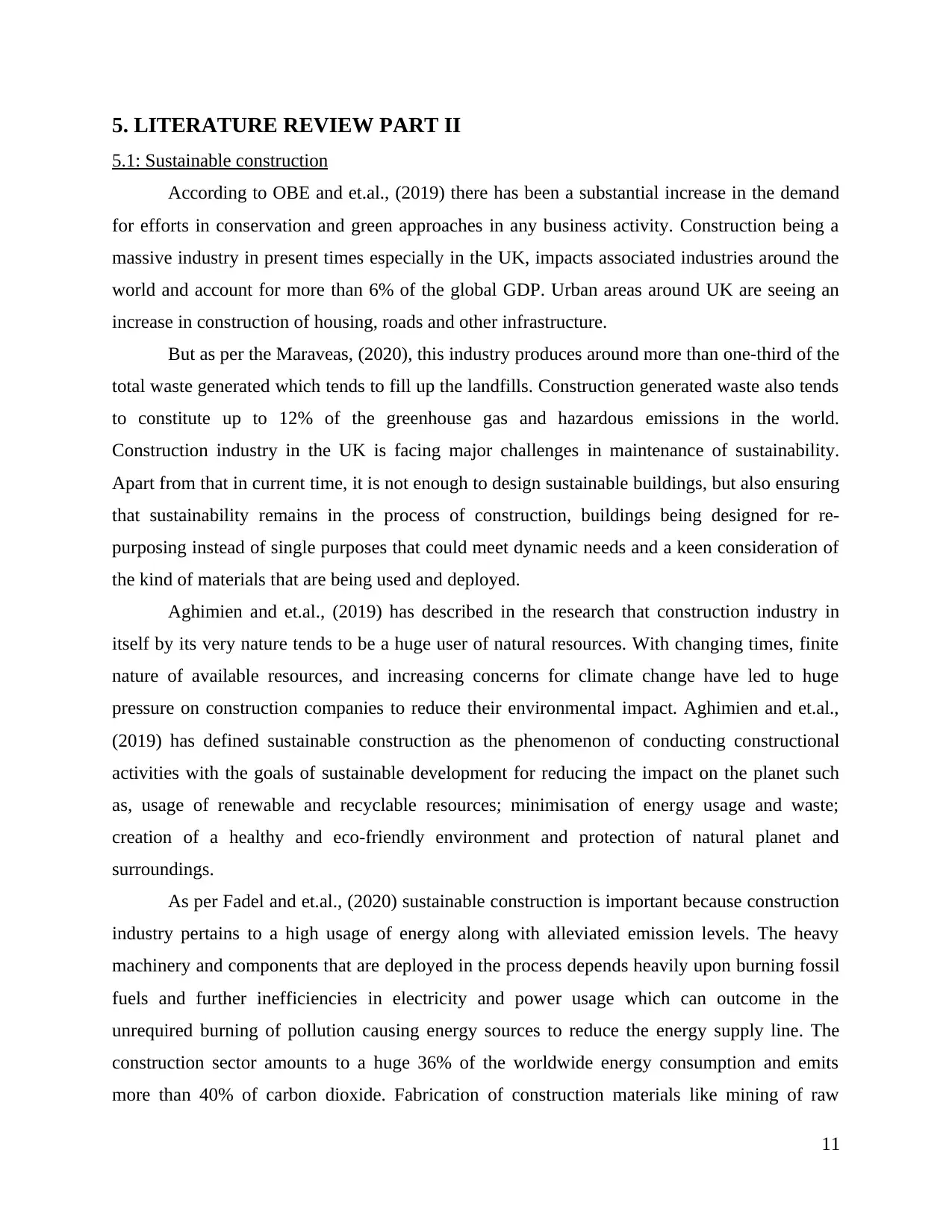
5. LITERATURE REVIEW PART II
5.1: Sustainable construction
According to OBE and et.al., (2019) there has been a substantial increase in the demand
for efforts in conservation and green approaches in any business activity. Construction being a
massive industry in present times especially in the UK, impacts associated industries around the
world and account for more than 6% of the global GDP. Urban areas around UK are seeing an
increase in construction of housing, roads and other infrastructure.
But as per the Maraveas, (2020), this industry produces around more than one-third of the
total waste generated which tends to fill up the landfills. Construction generated waste also tends
to constitute up to 12% of the greenhouse gas and hazardous emissions in the world.
Construction industry in the UK is facing major challenges in maintenance of sustainability.
Apart from that in current time, it is not enough to design sustainable buildings, but also ensuring
that sustainability remains in the process of construction, buildings being designed for re-
purposing instead of single purposes that could meet dynamic needs and a keen consideration of
the kind of materials that are being used and deployed.
Aghimien and et.al., (2019) has described in the research that construction industry in
itself by its very nature tends to be a huge user of natural resources. With changing times, finite
nature of available resources, and increasing concerns for climate change have led to huge
pressure on construction companies to reduce their environmental impact. Aghimien and et.al.,
(2019) has defined sustainable construction as the phenomenon of conducting constructional
activities with the goals of sustainable development for reducing the impact on the planet such
as, usage of renewable and recyclable resources; minimisation of energy usage and waste;
creation of a healthy and eco-friendly environment and protection of natural planet and
surroundings.
As per Fadel and et.al., (2020) sustainable construction is important because construction
industry pertains to a high usage of energy along with alleviated emission levels. The heavy
machinery and components that are deployed in the process depends heavily upon burning fossil
fuels and further inefficiencies in electricity and power usage which can outcome in the
unrequired burning of pollution causing energy sources to reduce the energy supply line. The
construction sector amounts to a huge 36% of the worldwide energy consumption and emits
more than 40% of carbon dioxide. Fabrication of construction materials like mining of raw
11
5.1: Sustainable construction
According to OBE and et.al., (2019) there has been a substantial increase in the demand
for efforts in conservation and green approaches in any business activity. Construction being a
massive industry in present times especially in the UK, impacts associated industries around the
world and account for more than 6% of the global GDP. Urban areas around UK are seeing an
increase in construction of housing, roads and other infrastructure.
But as per the Maraveas, (2020), this industry produces around more than one-third of the
total waste generated which tends to fill up the landfills. Construction generated waste also tends
to constitute up to 12% of the greenhouse gas and hazardous emissions in the world.
Construction industry in the UK is facing major challenges in maintenance of sustainability.
Apart from that in current time, it is not enough to design sustainable buildings, but also ensuring
that sustainability remains in the process of construction, buildings being designed for re-
purposing instead of single purposes that could meet dynamic needs and a keen consideration of
the kind of materials that are being used and deployed.
Aghimien and et.al., (2019) has described in the research that construction industry in
itself by its very nature tends to be a huge user of natural resources. With changing times, finite
nature of available resources, and increasing concerns for climate change have led to huge
pressure on construction companies to reduce their environmental impact. Aghimien and et.al.,
(2019) has defined sustainable construction as the phenomenon of conducting constructional
activities with the goals of sustainable development for reducing the impact on the planet such
as, usage of renewable and recyclable resources; minimisation of energy usage and waste;
creation of a healthy and eco-friendly environment and protection of natural planet and
surroundings.
As per Fadel and et.al., (2020) sustainable construction is important because construction
industry pertains to a high usage of energy along with alleviated emission levels. The heavy
machinery and components that are deployed in the process depends heavily upon burning fossil
fuels and further inefficiencies in electricity and power usage which can outcome in the
unrequired burning of pollution causing energy sources to reduce the energy supply line. The
construction sector amounts to a huge 36% of the worldwide energy consumption and emits
more than 40% of carbon dioxide. Fabrication of construction materials like mining of raw
11
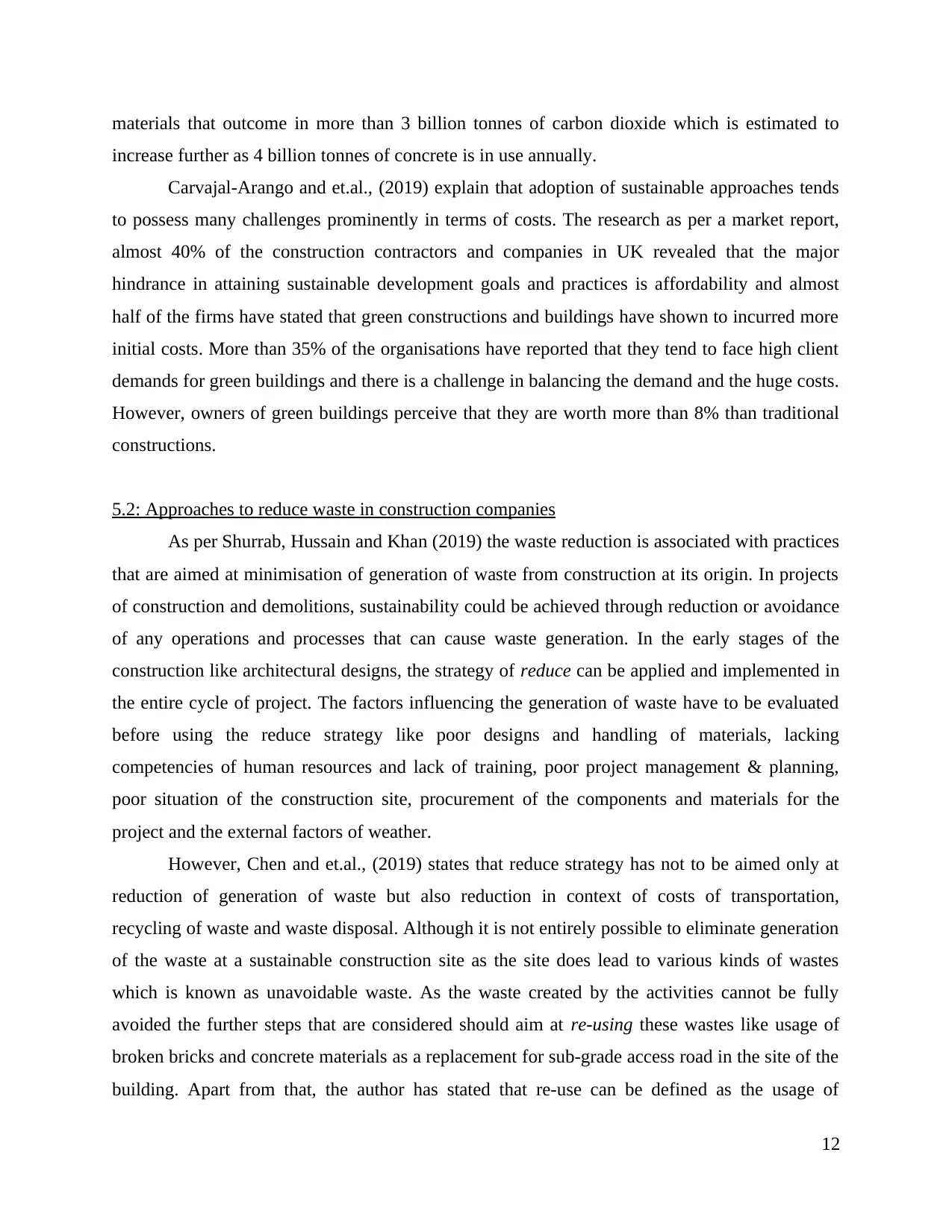
materials that outcome in more than 3 billion tonnes of carbon dioxide which is estimated to
increase further as 4 billion tonnes of concrete is in use annually.
Carvajal-Arango and et.al., (2019) explain that adoption of sustainable approaches tends
to possess many challenges prominently in terms of costs. The research as per a market report,
almost 40% of the construction contractors and companies in UK revealed that the major
hindrance in attaining sustainable development goals and practices is affordability and almost
half of the firms have stated that green constructions and buildings have shown to incurred more
initial costs. More than 35% of the organisations have reported that they tend to face high client
demands for green buildings and there is a challenge in balancing the demand and the huge costs.
However, owners of green buildings perceive that they are worth more than 8% than traditional
constructions.
5.2: Approaches to reduce waste in construction companies
As per Shurrab, Hussain and Khan (2019) the waste reduction is associated with practices
that are aimed at minimisation of generation of waste from construction at its origin. In projects
of construction and demolitions, sustainability could be achieved through reduction or avoidance
of any operations and processes that can cause waste generation. In the early stages of the
construction like architectural designs, the strategy of reduce can be applied and implemented in
the entire cycle of project. The factors influencing the generation of waste have to be evaluated
before using the reduce strategy like poor designs and handling of materials, lacking
competencies of human resources and lack of training, poor project management & planning,
poor situation of the construction site, procurement of the components and materials for the
project and the external factors of weather.
However, Chen and et.al., (2019) states that reduce strategy has not to be aimed only at
reduction of generation of waste but also reduction in context of costs of transportation,
recycling of waste and waste disposal. Although it is not entirely possible to eliminate generation
of the waste at a sustainable construction site as the site does lead to various kinds of wastes
which is known as unavoidable waste. As the waste created by the activities cannot be fully
avoided the further steps that are considered should aim at re-using these wastes like usage of
broken bricks and concrete materials as a replacement for sub-grade access road in the site of the
building. Apart from that, the author has stated that re-use can be defined as the usage of
12
increase further as 4 billion tonnes of concrete is in use annually.
Carvajal-Arango and et.al., (2019) explain that adoption of sustainable approaches tends
to possess many challenges prominently in terms of costs. The research as per a market report,
almost 40% of the construction contractors and companies in UK revealed that the major
hindrance in attaining sustainable development goals and practices is affordability and almost
half of the firms have stated that green constructions and buildings have shown to incurred more
initial costs. More than 35% of the organisations have reported that they tend to face high client
demands for green buildings and there is a challenge in balancing the demand and the huge costs.
However, owners of green buildings perceive that they are worth more than 8% than traditional
constructions.
5.2: Approaches to reduce waste in construction companies
As per Shurrab, Hussain and Khan (2019) the waste reduction is associated with practices
that are aimed at minimisation of generation of waste from construction at its origin. In projects
of construction and demolitions, sustainability could be achieved through reduction or avoidance
of any operations and processes that can cause waste generation. In the early stages of the
construction like architectural designs, the strategy of reduce can be applied and implemented in
the entire cycle of project. The factors influencing the generation of waste have to be evaluated
before using the reduce strategy like poor designs and handling of materials, lacking
competencies of human resources and lack of training, poor project management & planning,
poor situation of the construction site, procurement of the components and materials for the
project and the external factors of weather.
However, Chen and et.al., (2019) states that reduce strategy has not to be aimed only at
reduction of generation of waste but also reduction in context of costs of transportation,
recycling of waste and waste disposal. Although it is not entirely possible to eliminate generation
of the waste at a sustainable construction site as the site does lead to various kinds of wastes
which is known as unavoidable waste. As the waste created by the activities cannot be fully
avoided the further steps that are considered should aim at re-using these wastes like usage of
broken bricks and concrete materials as a replacement for sub-grade access road in the site of the
building. Apart from that, the author has stated that re-use can be defined as the usage of
12
⊘ This is a preview!⊘
Do you want full access?
Subscribe today to unlock all pages.

Trusted by 1+ million students worldwide
1 out of 36
Related Documents
Your All-in-One AI-Powered Toolkit for Academic Success.
+13062052269
info@desklib.com
Available 24*7 on WhatsApp / Email
![[object Object]](/_next/static/media/star-bottom.7253800d.svg)
Unlock your academic potential
Copyright © 2020–2025 A2Z Services. All Rights Reserved. Developed and managed by ZUCOL.




